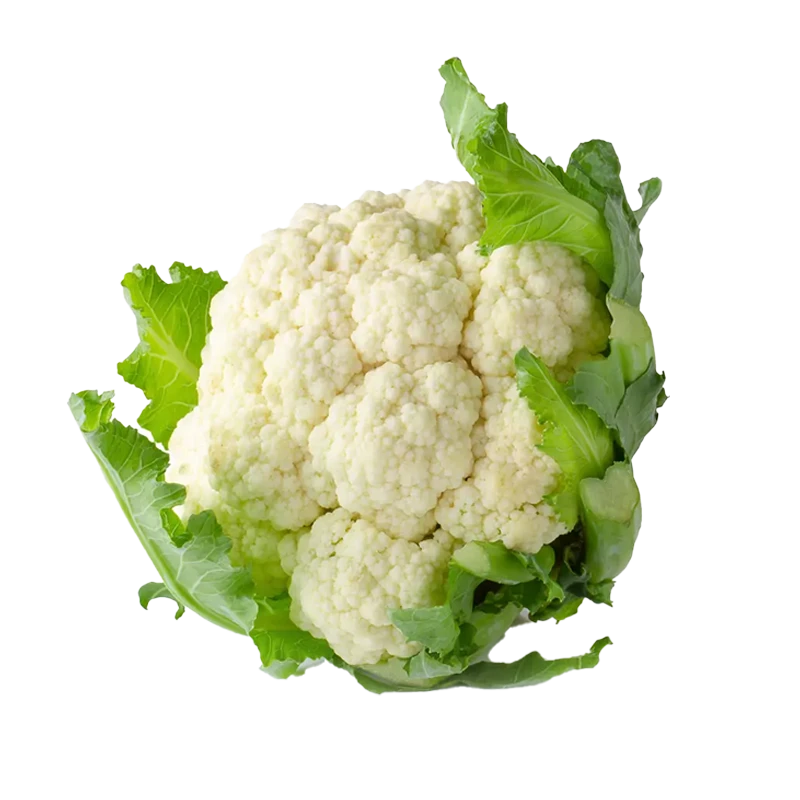Cauliflower — Nutrients, Health Benefits, And Shopping Tips

Written by Listonic Team
Last update on September 4, 2024
Nutrients
Nutrition facts
Amount per 100 g
Calories
🔥 25 kcal
| Nutrition per: 100 g | Value | % Daily Value* |
|---|---|---|
| Carbs | 5 g | 1.82% |
| Fiber | 2 g | 7.14% |
| Sugars | 2 g | 4% |
| Glycemic Index | 15 | - |
| Protein | 2 g | 4% |
| Sodium | 30 mg | 1.3% |
| Total Fat | 0 g | - |
*The % of Daily Value (DV) tells you how much a nutrient in a serving of food contributes to a daily diet. 2,000 calories a day is used for general nutrition advice.
25
🍏 Low-Calorie Foods
15
🟢 Low Glycemic Index
Key takeaways
Health benefits
- Rich in vitamins and minerals, such as Vitamin C, Vitamin K, folate, and potassium, which support overall health and well-being.
- High in fiber, promoting digestive health, regular bowel movements, and a healthy gut microbiome.
- Contains antioxidants, such as glucosinolates and isothiocyanates, which help protect the body from free radicals and reduce inflammation.
- Supports weight management due to its low calorie and high fiber content, promoting satiety.
- Versatile in cooking, offering various ways to include it in your diet, such as roasted, steamed, or mashed.
Health risks
- Digestive discomfort such as gas, bloating, or stomach cramps due to its high fiber content and certain carbohydrates that can be difficult to digest.
- Potential for goitrogens as cauliflower contains compounds that can interfere with thyroid function, particularly when consumed raw in large amounts.
- Pesticide residue on conventionally grown cauliflower, which can pose health risks over time if not properly washed.
- Possible interaction with blood thinners due to the presence of vitamin K, which can affect blood clotting in individuals taking these medications.
How to choose cauliflower
Cauliflower should have a uniform white color and tight, compact florets. The leaves around the base should be vibrant and green, suggesting the cauliflower is fresh. It should feel heavy for its size, indicating it's not dried out.
Avoid heads with dark spots or loose, spread-out florets, which can indicate age or poor quality. Good cauliflower should not have any signs of wilting or a strong odor.

How to store cauliflower
Fresh cauliflower should be stored in the refrigerator, preferably in the crisper drawer. Keep it in a perforated plastic bag to maintain its freshness. Properly stored, cauliflower can last up to a week.
Excess moisture can cause cauliflower to spoil quickly, so keep it dry. Storing it near ethylene-producing fruits can lead to faster spoilage. Do not wash before storing, as this can introduce moisture that speeds up decay.
✅ Extra Tip
How long does it last?
Cauliflower can last for 1-2 weeks in the refrigerator. To extend its freshness, store it in a plastic bag or container in the crisper drawer. Cooked cauliflower should be consumed within 3-5 days.
What to do with leftovers?
Leftover cauliflower can be used in a variety of dishes. Roast it with olive oil and spices for a delicious side dish, or use it as a base for a cauliflower mash as a low-carb alternative to potatoes. Cauliflower is also great in stir-fries or added to soups and stews for extra nutrition.
Use cauliflower in a casserole with cheese and breadcrumbs, or blend it into a cauliflower soup for a creamy, comforting dish. If you have a lot of cauliflower, consider making cauliflower rice by pulsing it in a food processor, then sautéing with your favorite seasonings. Cauliflower can also be used as a base for a grain-free pizza crust or blended into a cauliflower sauce for pasta. For a quick snack, try making cauliflower "wings" by roasting florets with buffalo sauce.
👨⚕️️ Medical disclaimer
Discover products from other categories
Listonic Team
Fact-checked
Our editorial team checked this article to make sure it was accurate at the time of publishing it.
Get the top-rated shopping list app on your phone!







